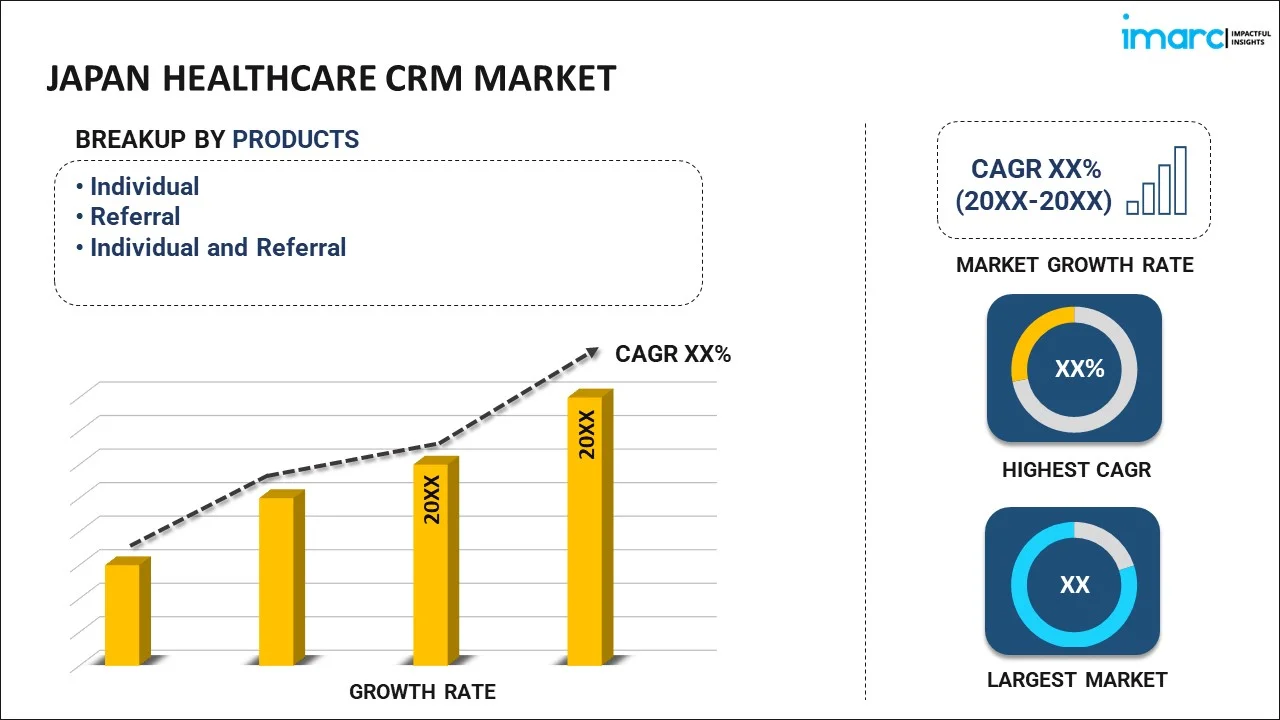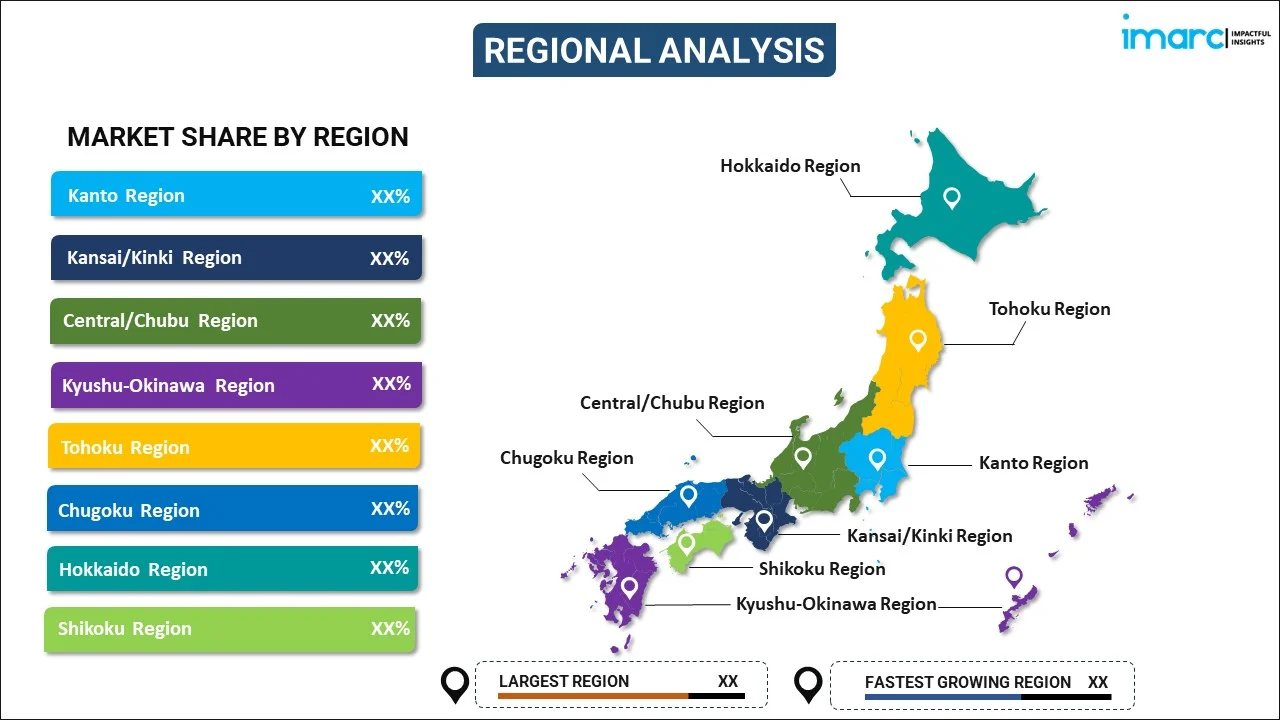
Japan Healthcare CRM Market Report by Product (Individual, Referral, Individual and Referral), Application (Community Outreach, Case Coordination, Case Management, Relationship Management), Technology (Cloud-based, Mobile, Social, Collaborative, Predictive), End Use (Payers, Providers, Life Science Companies), and Region 2025-2033
Market Overview:
Japan healthcare CRM market size reached USD 1,035 Million in 2024. Looking forward, IMARC Group expects the market to reach USD 2,120 Million by 2033, exhibiting a growth rate (CAGR) of 8.30% during 2025-2033. The increasing adoption of healthcare CRM by healthcare institutions, rising need to manage referrals and coordinate care between different providers, and the growing reliance on mobile health (mHealth) applications represent some of the key factors driving the market.
|
Report Attribute
|
Key Statistics
|
|---|---|
|
Base Year
|
2024 |
|
Forecast Years
|
2025-2033
|
|
Historical Years
|
2019-2024
|
| Market Size in 2024 | USD 1,035 Million |
| Market Forecast in 2033 | USD 2,120 Million |
| Market Growth Rate (2025-2033) | 8.30% |
Healthcare customer relationship management (CRM) is a comprehensive approach that focuses on improving patient engagement, satisfaction, and outcomes. It centralizes patient information, including medical history, appointments, and billing, which allows healthcare providers to offer personalized care. It also helps in managing and automating administrative tasks, such as appointment scheduling and follow-up reminders, reducing administrative burdens. It can capture and analyze patient data to identify trends and preferences, which aid in tailored care plans and predictive analytics for better decision-making. Additionally, it enhances communication between patients and providers, which makes it easier to address concerns, provide telehealth services, and maintain strong doctor-patient relationships. It also assists in marketing and outreach efforts by segmenting patient populations for targeted campaigns and referral tracking, which enables healthcare institutions to attract new patients and retain existing ones.
Japan Healthcare CRM Market Trends:
The rising emphasis on providing patient-centered healthcare is driving the need for healthcare CRM systems to enhance patient engagement and satisfaction. Along with this, the increasing adoption of healthcare CRM by healthcare institutions to record, analyze, and utilize patient information effectively represents one of the major factors bolstering the market growth in Japan. Moreover, the growing utilization of telehealth services is driving the need for CRM tools to manage remote patient interactions and appointments. In addition, the increasing need to manage referrals and coordinate care between different providers is favoring the market growth. Apart from this, the rising utilization of healthcare CRM for improving the patient experience, which is becoming a priority for healthcare institutions seeking to differentiate themselves, is strengthening the growth of the market in the country. Furthermore, key players operating in the country are focusing on using artificial intelligence (AI), machine learning (ML), data analytics, the Internet of Things (IoT), and chatbots and virtual assistants. These advancements can analyze patient data to provide personalized treatment recommendations, predict patient needs, automate routine tasks, and allow healthcare CRM systems to process vast amounts of patient data to identify trends, optimize workflows, and improve decision-making. Leading players are also incorporating blockchain, facial recognition, and predictive analytics to ensure the security and integrity of patient records, reducing the risk of data breaches and enhancing patient trust. These advanced technologies can be used for transcribing patient notes and streamlining data entry, reducing administrative burdens, and forecasting patient needs, disease outbreaks, and resource requirements, optimizing resource allocation and patient care. This, coupled with the rising reliance on mobile health (mHealth) applications, is enhancing the accessibility and convenience to avail medical services, which is propelling the growth of the market in the country.
Japan Healthcare CRM Market Segmentation:
IMARC Group provides an analysis of the key trends in each segment of the market, along with forecasts at the country level for 2025-2033. Our report has categorized the market based on product, application, technology, and end use.
Product Insights:

- Individual
- Referral
- Individual and Referral
The report has provided a detailed breakup and analysis of the market based on the product. This includes individual, referral and individual and referral.
Application Insights:
- Community Outreach
- Case Coordination
- Case Management
- Relationship Management
A detailed breakup and analysis of the market based on the application have also been provided in the report. This includes community outreach, case coordination, case management, and relationship management.
Technology Insights:
- Cloud-based
- Mobile
- Social
- Collaborative
- Predictive
The report has provided a detailed breakup and analysis of the market based on the technology. This includes cloud-based, mobile, social, collaborative, and predictive.
End Use Insights:
- Payers
- Providers
- Life Science Companies
A detailed breakup and analysis of the market based on the end use have also been provided in the report. This includes payers, providers, and life science companies.
Regional Insights:

- Kanto Region
- Kansai/Kinki Region
- Central/ Chubu Region
- Kyushu-Okinawa Region
- Tohoku Region
- Chugoku Region
- Hokkaido Region
- Shikoku Region
The report has also provided a comprehensive analysis of all the major regional markets, which include Kanto Region, Kansai/Kinki Region, Central/ Chubu Region, Kyushu-Okinawa Region, Tohoku Region, Chugoku Region, Hokkaido Region, and Shikoku Region.
Competitive Landscape:
The market research report has also provided a comprehensive analysis of the competitive landscape. Competitive analysis such as market structure, key player positioning, top winning strategies, competitive dashboard, and company evaluation quadrant has been covered in the report. Also, detailed profiles of all major companies have been provided.
Japan Healthcare CRM Market Report Coverage:
| Report Features | Details |
|---|---|
| Base Year of the Analysis | 2024 |
| Historical Period | 2019-2024 |
| Forecast Period | 2025-2033 |
| Units | Million USD |
| Scope of the Report | Exploration of Historical and Forecast Trends, Industry Catalysts and Challenges, Segment-Wise Historical and Predictive Market Assessment:
|
| Products Covered | Individual, Referral, Individual and Referral |
| Applications Covered | Community Outreach, Case Coordination, Case Management, Relationship Management |
| Technologies Covered | Cloud-based, Mobile, Social, Collaborative, Predictive |
| End Uses Covered | Payers, Providers, Life Science Companies |
| Regions Covered | Kanto Region, Kansai/Kinki Region, Central/ Chubu Region, Kyushu-Okinawa Region, Tohoku Region, Chugoku Region, Hokkaido Region, Shikoku Region |
| Customization Scope | 10% Free Customization |
| Post-Sale Analyst Support | 10-12 Weeks |
| Delivery Format | PDF and Excel through Email (We can also provide the editable version of the report in PPT/Word format on special request) |
Key Questions Answered in This Report:
- How has the Japan healthcare CRM market performed so far and how will it perform in the coming years?
- What has been the impact of COVID-19 on the Japan healthcare CRM market?
- What is the breakup of the Japan healthcare CRM market on the basis of product?
- What is the breakup of the Japan healthcare CRM market on the basis of application?
- What is the breakup of the Japan healthcare CRM market on the basis of technology?
- What is the breakup of the Japan healthcare CRM market on the basis of end use?
- What are the various stages in the value chain of the Japan healthcare CRM market?
- What are the key driving factors and challenges in the Japan healthcare CRM?
- What is the structure of the Japan healthcare CRM market and who are the key players?
- What is the degree of competition in the Japan healthcare CRM market?
Key Benefits for Stakeholders:
- IMARC’s industry report offers a comprehensive quantitative analysis of various market segments, historical and current market trends, market forecasts, and dynamics of the Japan healthcare CRM market from 2019-2033.
- The research report provides the latest information on the market drivers, challenges, and opportunities in the Japan healthcare CRM market.
- Porter's five forces analysis assist stakeholders in assessing the impact of new entrants, competitive rivalry, supplier power, buyer power, and the threat of substitution. It helps stakeholders to analyze the level of competition within the Japan healthcare CRM industry and its attractiveness.
- Competitive landscape allows stakeholders to understand their competitive environment and provides an insight into the current positions of key players in the market.
Need more help?
- Speak to our experienced analysts for insights on the current market scenarios.
- Include additional segments and countries to customize the report as per your requirement.
- Gain an unparalleled competitive advantage in your domain by understanding how to utilize the report and positively impacting your operations and revenue.
- For further assistance, please connect with our analysts.
 Inquire Before Buying
Inquire Before Buying
 Speak to an Analyst
Speak to an Analyst
 Request Brochure
Request Brochure
 Request Customization
Request Customization




.webp)




.webp)












